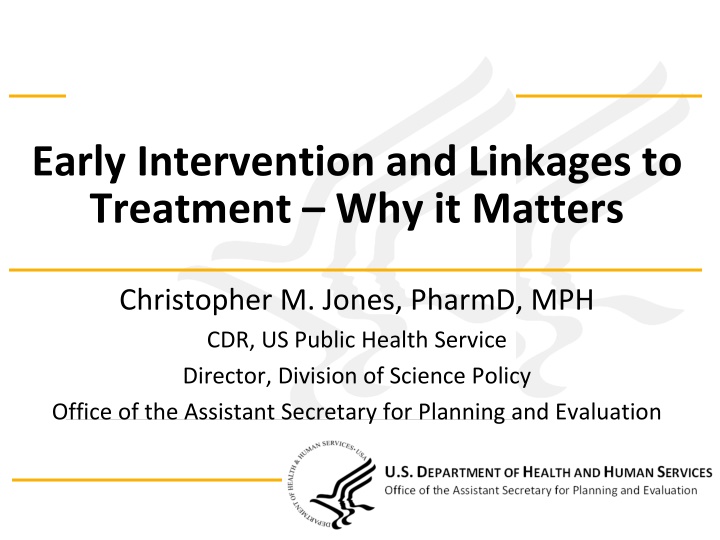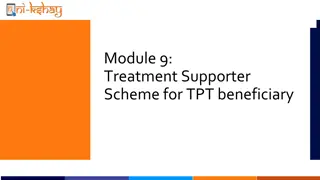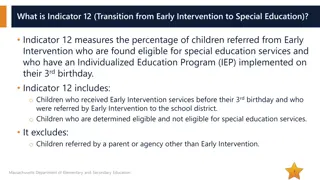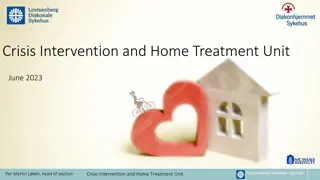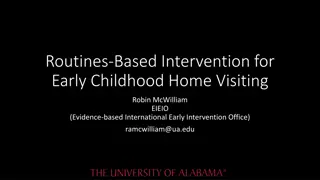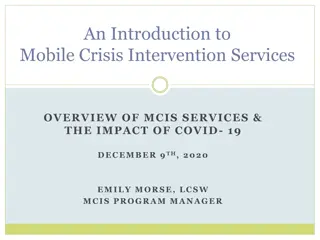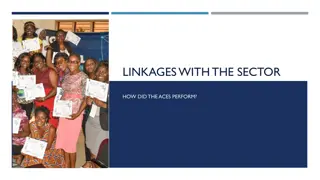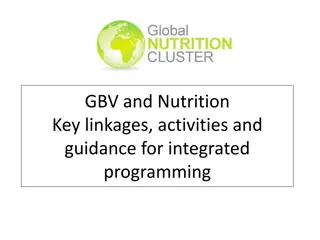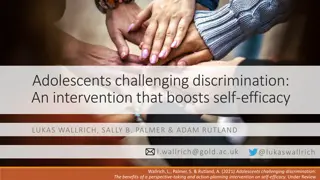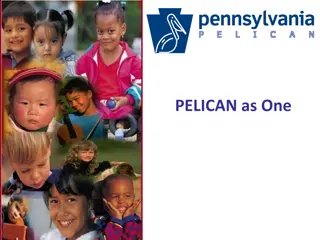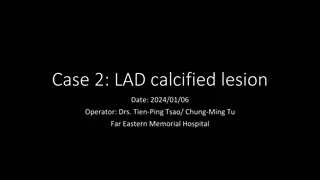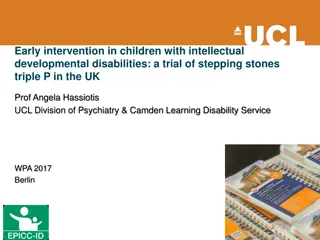Early Intervention and Treatment Linkages: Why it Matters
This presentation by Christopher M. Jones focuses on the importance of early intervention and linkages to treatment in addressing opioid-related issues. It covers epidemiological trends, treatment challenges, and the significant risk factors associated with nonmedical use of prescription opioids leading to heroin use. The visuals included provide data on past-year opioid use disorders, opioid-related overdose deaths, and the relationship between nonmedical use of prescription opioids and heroin use.
Download Presentation

Please find below an Image/Link to download the presentation.
The content on the website is provided AS IS for your information and personal use only. It may not be sold, licensed, or shared on other websites without obtaining consent from the author.If you encounter any issues during the download, it is possible that the publisher has removed the file from their server.
You are allowed to download the files provided on this website for personal or commercial use, subject to the condition that they are used lawfully. All files are the property of their respective owners.
The content on the website is provided AS IS for your information and personal use only. It may not be sold, licensed, or shared on other websites without obtaining consent from the author.
E N D
Presentation Transcript
Early Intervention and Linkages to Treatment Why it Matters Christopher M. Jones, PharmD, MPH CDR, US Public Health Service Director, Division of Science Policy Office of the Assistant Secretary for Planning and Evaluation
Overview Epidemiological trends Treatment challenges Early Intervention, Integration, and Linkages to Treatment Conclusions
Past year nonmedical use of prescription opioids and heroin use 14 1.6 Prescription opioids No. of Persons with Nonmedical Use of Prescription Opioids in Previous Year No. of Persons with Heroin Use during the Previous Year (in millions) 1.4 12.65 12 12.52 12.49 12.45 12.24 11.92 11.82 11.67 11.26 11.14 1.2 11.08 10.99 10 10.34 1.0 Heroin 8 0.91 (in millions) 0.8 6 0.68 0.67 0.6 0.62 0.62 0.58 0.56 4 0.4 0.46 0.40 0.40 0.38 0.37 0.31 2 0.2 0 0.0 2002 2003 2004 2005 2006 2007 2008 2009 2010 2011 2012 2013 2014 Year Source: SAMHSA, NSDUH 2002-2014 PUF
Past year opioid use disorders, US, 2003-2014 Any Opioid Use Disorder Prescription Opioid Use Disorder Heroin Use Disorder 2,500,000 2,000,000 1,500,000 Number of Individuals 1,000,000 500,000 0 2003 2004 2005 2006 2007 2008 2009 2010 2011 2012 2013 2014 Source: SAMHSA, NSDUH 2003-2014 PUF
Opioid-related overdose deaths, US, 1999-2014 All Opioids Heroin Natural/Semi-Sythetic Opioids Synthetic Opioids 10 9 8 Age Adjusted-Rate per 100,000 population 7 6 5 4 3 2 1 0 1999 2000 2001 2002 2003 2004 2005 2006 2007 2008 2009 2010 2011 2012 2013 2014 Source: CDC, NVSS, 2016
Nonmedical use of Rx opioids significant risk factor for heroin use 3 out of 4 people who used heroin in the past year misused opioids first 7 out of 10 people who used heroin in the past year also misused opioids in the past year Source: Jones, C.M., Heroin use and heroin use risk behaviors among nonmedical users of prescription opioid pain relievers United States, 2002 2004 and 2008 2010. Drug Alcohol Depend. (2013). Slide credit Grant Baldwin, CDC
National Rates of Abuse of Opioids in the Previous Month among 15,227 Respondents Cicero TJ et al. N Engl J Med 2015;373:1789-1790.
Risk of heroin use and high-risk behaviors by frequency of Rx opioid nonmedical use 30-99 Days PY Nonmedical Use vs 1-29 Days PY Nonmedical Use 100-365 Days PY Nonmedical Use vs 1-29 Days PY Nonmedical Use 15 13.3 13 11 8.9 Adjusted Odds Ratio 9 7.8 6.4 7 5 4.3 3.8 3.2 2.9 2.8 3 2.1 1.6 1.4 1 heroin fairly or very easy to obtain past year heroin use past year heroin abuse or dependence past year Rx opioid abuse or dependence ever inject heroin ever inject Rx opioids -1 Source: Jones, C.M., Heroin use and heroin use risk behaviors among nonmedical users of prescription opioid pain relievers United States, 2002 2004 and 2008 2010. Drug Alcohol Depend. (2013). Slide credit Grant Baldwin, CDC
Frequent nonmedical users of Rx opioids and those with abuse/dependence most likely to initiate heroin 3.6% of nonmedical users of Rx opioids had initiated heroin use within 5 years of initiating nonmedical use Initiation rate of <1.0% per year 2002-2004 2005-2008 2009-2011 8% 7% Percent Reporting Past Year Heroin Use 6% 5% 4% 3% 2% 1% 0% 0 Days 1-29 Days 30-99 Days 100-199 Days 200-365 Days No Past Year Abuse/Dependence Past Year Abuse/Dependence Source: Muhuri et al. , Associations of Nonmedical Pain Reliever Use and Initiation of Heroin Use in the United States. SAMHSA, 2013
Heroin initiation rates among people nonmedically using Rx opioids 27 of 362 (7.5%) initiated heroin use during 36 months of study Transition rate of 2.8% per year Carlson et al 2016 Columbus, Ohio Age 18-23 at recruitment in 2009-2010 NMU of Rx opioids 5 day in past 90 days No Hx of lifetime opioid dependence No Hx of heroin use or IDU Not involved in CJ system or SUD Tx in past 30 days Followed for 3 years aHR for heroin transition 7 6.6 6 4.8 5 4 3.1 3 2.4 2 1 0 PO dependence (lifetime) Early initiation ( 15 years) Only use PO to get high (lifetime) Non-oral route most often Source: Carlson et al. Drug Alcohol Depend. 2016;160:127-134
Non-Oral Routes of Rx Opioid Misuse Increasing in the U.S. Oral Non-Oral/Non-Injection Injection 100% Percent of Primary Prescription Opioid Misusers 10.2 11.1 11.3 11.7 12.0 12.6 14.4 16.2 17.0 18.1 90% 15.3 18.8 80% 16.2 17.8 19.8 21.4 23.8 25.3 24.5 23.0 70% 60% 50% 40% 73.1 71.8 71.0 71.0 69.1 66.1 61.7 30% 58.9 58.5 58.5 20% 10% 0% 2004 2005 2006 2007 2008 2009 2010 2011 2012 2013 Year Source: Jones, Christensen, Gladden, 2016 Manuscript Under Development
Rise in heroin overdose deaths strongly correlated with increase in heroin abuse or dependence Past Year Heroin Abuse or Dependence Heroin-Related Overdose Deaths 3.0 3.0 Rate of past year heroin abuse or dependence per Rate of heroin-related overdose deaths per 100,000 2.5 2.5 1,000 persons aged 12 years and older 2.0 2.0 persons 1.5 1.5 1.0 1.0 0.5 0.5 0.0 0.0 2002 2003 2004 2005 2006 2007 2008 2009 2010 2011 2012 2013 Source: Jones CM, Logan J, Gladden M, Bohm M, Demographic and substance use trends among heroin users, US, 2002-2013. MMWR, 2015.
Past year substance abuse or dependence among past year heroin users 14 Source: Jones CM, Logan J, Gladden M, Bohm M, Demographic and substance use trends among heroin users, US, 2002-2013. MMWR, 2015.
Circumstances of Rx opioid nonmedical use and heroin initiation Inciardi et al., 2009 Interviews in 12/2006 Rx opioids preceded heroin Rx opioid dependence, social context, economics, and availability major factors in heroin initiation Harocops et al., 2016 Interviews between 8/2013 and 1/2015 Cycle of oral to intranasal to injection Dependence, social context, economics, and availability all factors in heroin initiation Median time from first Rx opioid misuse to heroin use was 3 years Among those with no Hx of IDU prior to heroin initiation, median time between intranasal and IV heroin use was 6 months Source: Inciardi et al., Pain Med. 2009; 10:537-48; Harocops et al., Int J Drug Policy 2016;28:106-112
People with opioid use disorders are not receiving treatment 2,500,000 2,239,768 2,000,000 1,500,000 Number of Individuals 1,000,000 655,575 520,972 500,000 0 Any Opioid Use Disorder Received Treatment for Illicit Drugs or Alcohol Use in Past Year Received Treatment at Specialty Facility Source: Jones CM 2016 NSDUH PUF
Reasons why people didnt get treatment Reason Percentage Treatment Cost/No Insurance/Insurance didn t cover treatment 47.8 Not ready to stop use/Didn t feel need for treatment/Could handle problem without treatment 35.0 Stigma 30.2 Awareness of treatment 12.3 Other 11.7 Availability of treatment Source: Jones CM 2016 NSDUH PUF 10.2
Opioid abuse and dependence exceeds OA-MAT capacity in most states Rate of OA-MAT capacity Rate of past year opioid abuse or dependence Source: Jones CM, Campopiano M, Baldwin G, McCance-Katz E. National and State Treatment Need and Capacity for Opioid Agonist Medication-Assisted Treatment. American Journal of Public Health, 2015;e1-e9.
Rate of Past Year Opioid Abuse or Dependence and Rate of OA-MAT Capacity (rate per 1,000 persons aged 12 years and older) Rate of Opioid Abuse/Dependence 3.4-6.4 6.5-9.2 9.4-10.3 10.8-12.9 Rate of OA-MAT Capacity 0.7-3.0 3.2-4.3 4.4-7.2 7.3-16.5 Source: Jones CM, Campopiano M, Baldwin G, McCance-Katz E. National and state treatment need and capacity for opioid agonist medication assisted treatment. AJPH. 2015
Providers are not talking to patients about substance use 15.7 % of people have talked with a healthcare professional about drinking 14% of people with risky drinking habits have been asked and advised about their drinking 55% of individuals in substance abuse treatment have said their primary care physician did nothing about their substance use Source: Harris 2016
EARLY INTERVENTION, INTEGRATION, AND LINKAGES TO TREATMENT
Behavioral health integration Need to integrate behavioral health care within medical settings is widely recognized among healthcare professionals Integrative approaches have been found to improve Physical health Mental health Quality of life outcomes for a range of chronic diseases Substance use disorder outcomes Many barriers to implementing integration Source: Brooks, 2016
Commonly identified barriers Lack of education/training Limited time and resources Negative attitudes about substance use Limited self-efficacy about addressing substance use Competing demands 25 Source: Harris 2016
SCREENING, BRIEF INTERVENTION, AND REFERRAL TO TREATMENT
SBIRT Intended to be implemented in healthcare and other community service settings frequented by the general public Screening Universal and opportunistic; questionnaires or instruments to evaluate whether individual has experienced, or is at-risk of experiencing, substance use-related harms Brief Intervention Typically for individuals at low- to-moderate risk of harms via Usually in-person, time-limited to provide advice and skills to reduce consequences Referral to Treatment Typically reserved for individuals experiencing significant harm and/or having more serious signs of substance dependence warranting formal diagnosis Medication-assisted treatment or other evidence-based treatment Source: Young, 2014
Spectrum of action Source: Strobbe, 2014
FRAMES for Brief Intervention Feedback Given to patient about personal risk or impairment Responsibility For change is with the patient Advice To change is given by provider Menu Options offered for behavioral change, supports, and/or treatment Empathic Empathy is used during interaction Self-efficacy Empowerment is engendered in patient Source: Strobbe, 2014
Evidence on Brief Interventions Positive effects for alcohol Mixed for other substances Despite mixed evidence for drug use, SBIRT is supported and funded by the Federal government
Providers believe it is their responsibility to: 100 88.5 88 90 83.3 82.8 80 70 60 51.6 Percent 50 40 30 20 10 0 Ask patients about their substance use Screen patients for substance use using a standardized tool Assess patients readiness to change their risky substance use Advise patients to change their risk substance use Refere patients with substance use problems to specialty treatment Source: Harris, 2016
How effective providers believe they are at: 60 51.6 50 40 33.9 32.8 Percent 30 20 10 0 Effective at helping patients reduce their alcohol consumption Effective at helping patients reduce their illicit drug use Effective at helping patients use their prescription drugs responsibly Source: Harris, 2016
Percent of providers conducting SBIRT elements 60 55.6 50 47.2 45.5 40 35.4 Percent 30 20 10 0 Screening Brief Intervention Referral to treatment Non of the above Source: Harris, 2016
Computerized vs In-Person Brief Intervention Computerized BI might help to avoid some of the common adoption barriers such as costs and personnel time RCT at two rural CHCs in NM Computerized BI vs In-Person BI Computerized BI showed similar results to In-Person BI and in some cases trended towards better outcomes More research is needed, but this approach along with other tele-health and remote technologies might help expand these types of services Source: Gryczynski, 2015
SBIRT and early intervention approaches State examples New Mexico Vermont New York South Carolina Ohio Other examples Pre-trial diversion programs Drug courts HIV clinics FQHCs 35
EXPANDING TREATMENT AND LINKAGES TO TREATMENT
Treatment need for opioid abuse or dependence exceeds capacity for opioid agonist medication assisted treatment (OA-MAT) in the US 2,500,000 2,000,000 Past Year Opioid Abuse or Dependence Number of Individuals 1,500,000 OA-MAT Capacity Maximum Potential Buprenorphine Capacity 1,000,000 OTP Patients on Methadone 500,000 0 2003 2004 2005 2006 2007 2008 2009 2010 2011 2012 Year Source: Jones CM, Campopiano M, Baldwin G, McCance-Katz E. National and state treatment need and capacity for opioid agonist medication assisted treatment. AJPH. 2015
Hub and Spoke Model Goals + An established physician-led medical home + A single MAT prescriber + A pharmacy home + Access to existing Community Health Teams + Access to Hub or Spoke nurses and clinicians + Linkages between Hubs and primary care Spoke providers in their areas Vermont Department of Health Source: Cimaglio 2015
Massachusetts Collaborative Care Model Goal: Implement office-based buprenorphine treatment in 14 community health centers Collaborative between physicians and nurse care managers Program expanded the number of DATA-waived physicians by 375% (from 24 to 114) within 3 years Significant increase in number of patients receiving buprenorphine treatment 67% of patients were in treatment for >12 months in 2013 Sustainable funding model Source: LaBelle CT, et al. Office-based treatment with buprenorphine (OBOT-B): state-wide implementation of the Massachusetts collaborative care model in community health centers. J Subs Abuse Treat. 2015.
RCT of ED-Initiated Buprenorphine 3 interventions Screening and referral to treatment (referral) Screening, brief intervention, and facilitated referral to community-based treatment (brief intervention) Screening, brief intervention, ED-initiated treatment with buprenorphine/naloxone, and referral to primary care for 10 week follow up (buprenorphine) buprenorphine referral brief intervention 100 90 83.3 78.0 80 70 57.6 57.10 55.6 53.8 60 Percent 45.00 50 42.90 37.0 40 30 20 10 0 Engaged in Tx at 30 days Negative UDTs Decrease in days of illicit opioid use per week Findings related to treatment engagement and self-reported days of illicit opioid use per week are statistically significantly different for buprenorphine compared to other interventions Source: Emergency department-initiated buprenorphine/naloxone treatment for opioid dependence: a randomized clinical trial. JAMA 2015.
Physician-Pharmacist Collaborative Practice Model Pilot Small pilot (n=12) for 12 months 135 follow up visits 91% attendance rate 100% 6-month retention rate 73% 12-month retention rate 88% of UDTs were positive for buprenorphine and negative for other opioids Estimated $22,000 in savings to program versus historical care provision Source: DiPaula BA. Physician-pharmacist collaborative care model for buprenorphine-maintained opioid-dependent patients. J Am Pharm Assoc. 2015.
Conclusions There is a real sense of urgency to address the public health crisis of opioid misuse and use disorder Early identification of problematic opioid use and engagement in appropriate levels of treatment are critical in preventing morbidity and mortality Many different models are being tested and more research is needed to identify the most effective approaches Collaboration with all key stakeholders is paramount
THANK YOU QUESTIONS? CHRISTOPHER.JONES@HHS.GOV
